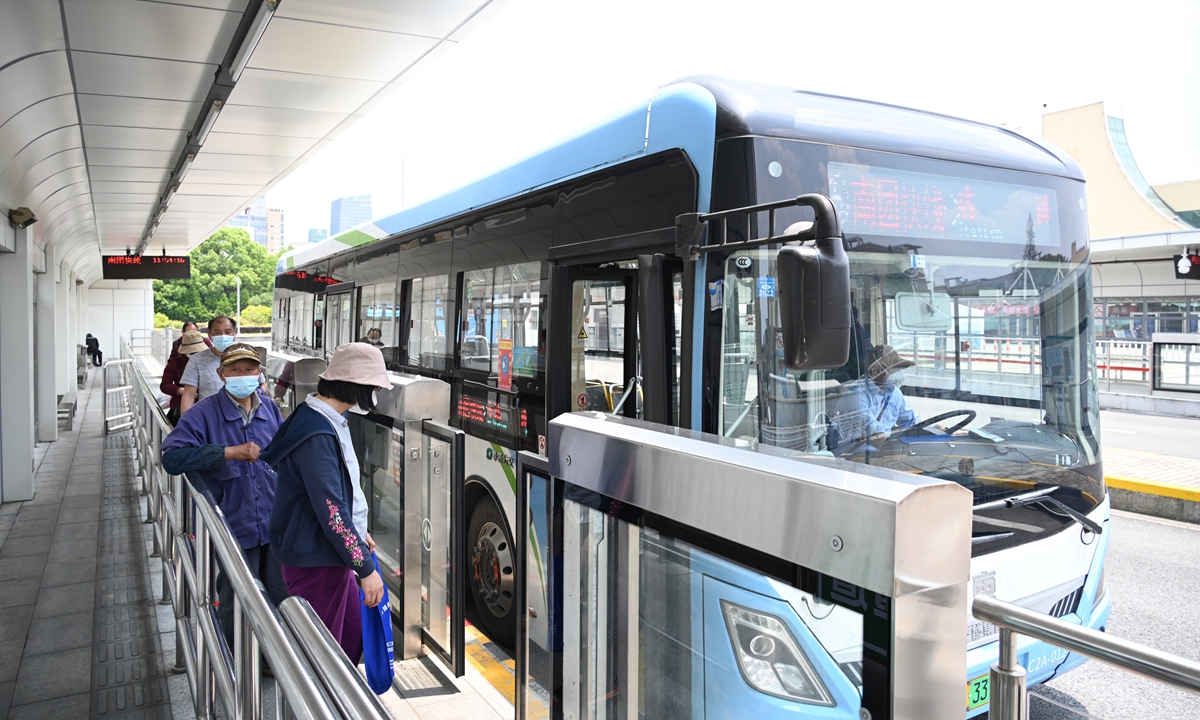
People wait in line to get on a bus. Bus service partly resumed in Shanghai on May 16. Photo: thepaper.cn
Shanghai plans to gradually restore cross-district public transport starting from Sunday under strict epidemic prevention and control measures, while giving priority to routes connecting airports, railway stations and major hospitals, Shanghai's Deputy Mayor Zhang Wei said on Thursday.
With the epidemic gradually fading, rail transit will resume on four lines and buses will resume operation on 273 routes, with a network covering all the central urban areas, including eight routes connecting Shanghai Hongqiao and Pudong airports, and 19 routes connecting Shanghai and Hongqiao railway stations, Zhang said at a press conference.
Metro Line 10 connects the Hongqiao transportation hub with the regions in the Pudong New Area, going between east and west across the city, which means people can move freely across the Huangpu River separating the city into two parts — Pudong and Puxi — once the line resumes.
Residents who have an urgent need to leave Shanghai still have to follow preventive measures and requirements in terms of negative tests obtained within 24 or 48 hours, to avoid spreading the virus outside the borders of Shanghai.
Public transportation will also be monitored to ensure safe travels for all passengers. A "venue code" will need to be scanned before entering the vehicle, to show a negative nucleic acid testing result obtained within the previous 48 hours, according to Zhang.
Additionally, all passengers will need to wear face masks, show a green health code and have their temperatures taken, Yu Fulin, an official with Shanghai's transportation commission, said at the briefing.
In suburban districts including Jinshan, Fengxian and Chongming, the city has been testing the new system and gradually restarted bus and taxi services within the districts, said local authorities on Thursday.
The two main bus lines going to local supermarkets and hospitals have resumed operation, a worker at Shanghai Jinshan Bus Co told the Global Times on Thursday. More than 800 passenger trips were made via these two bus lines on Wednesday and Thursday, according to the staffer.
In addition to public transportation, many enterprises are also preparing to resume work. Due to the fast spread of Omicron, enterprises face risks in resuming work, and it's crucial for them to meet high standards of epidemic prevention measures, said the deputy mayor. The city will cautiously support enterprises to return to work in two phases.
Firms will mainly operate under closed-loop or semi-closed-loop management until the end of May and a small number of employees will be allowed to return to work under the closed-loop mechanism for no more than a week and then return home, the deputy mayor said.
From the beginning of June, companies will be able to resume normal communications with communities in regions without epidemic risks, said Zhang, the deputy mayor.
Lu Hongzhou, head of Shenzhen's anti-epidemic expert team and head of the Third People's Hospital of Shenzhen, stressed the importance of insisting on regular epidemic prevention and control measures.
"Resuming social activities will surely result in people gathering, so nucleic acid testing remains fundamental in identifying any possible transmission source as soon as possible and avoiding a resurgence of the epidemic," Lu said.
Some Chinese cities, including epidemic-hit Shanghai and Beijing, have been preparing nucleic acid testing services that can be accessed by anyone within a 15-minute walk as a preventive measure to curb the rapidly spreading Omicron variant.
A 10-employee trade company owner surnamed Yang told the Global Times on Thursday that his company is indeed faced with difficulties amid the ongoing epidemic as it has been working at home and couldn't deliver goods to consumers. Yang has to pay more than 100,000 yuan ($15,648) of salaries and 80,000 yuan of rent for office and warehouse space each month.
Fabrice Megarbane, president of L'Oréal North Asia and CEO of L'Oréal China, told the Global Times that the company has confidence in the Chinese market as it believes that the consumption ability of consumers will quickly recover, and so will the market and economy. In early May, L'Oréal founded its first investment company in China, which is located in Shanghai's Fengxian district.
The company has witnessed the Chinese beauty market's development for 25 years, L'Oréal China is among the first batch of whitelist enterprises to resume production. The company has prepared raw materials for its factories as well as products for physical stores to welcome consumers in the coming weeks, Megarbane said, noting that the resumption of work will be carried out in phases when conditions allow.
About 50 percent of Taiwan-invested companies in Shanghai have resumed production and they are predicted to restart fully in June, according to media reports.
On Wednesday the city reported 82 new locally transmitted COVID-19 cases and 637 asymptomatic cases, all in areas under quarantine, Zhao Dandan, a deputy director of Shanghai's Municipal Health Commission, said at Thursday's press briefing. As of Wednesday, more than 20.2 million residents had been put under "prevention-level" regions, which mean that they are able to move freely within certain areas at certain times, according to Zhao.




